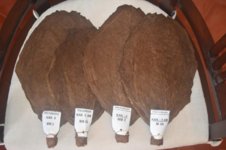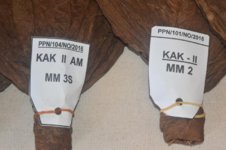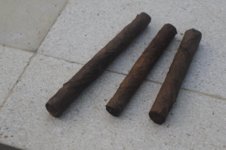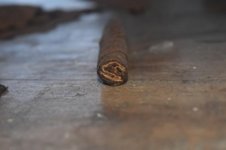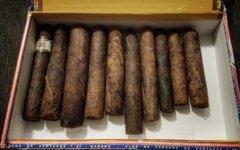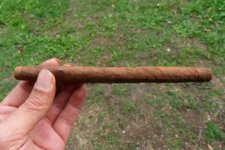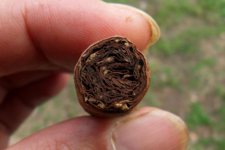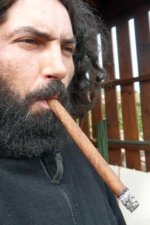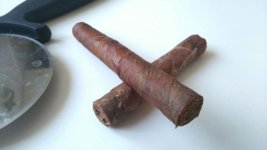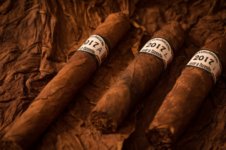Tutu
Well-Known Member
This is wrapped in the VBN/FIK 2007 wrapper from Perantara (via WLT). It's been an ordeal, trying to decipher the "FIK" part of this classification. There is no question that FIK is listed separately from VBN shade-grown Indonesian leaf by the broker, Perantara. But this sample (see below) clearly indicates "VBN/FIK".
"FIK" is, I assume, derived from a phrase in Dutch, but I haven't been able to make too much sense of it. The best I've come up with is that it indicates leaf that has somehow been subjected to either heat or smoke. But this wrapper does not have the smokey aroma of, say, San Andrés wrapper from Mexico, which is subjected to light smoke exposure from drying fires in the barns.
Perhaps Tutu can clarify what the "FIK" term means here.
I can say that, unlike Sumatra wrapper, this leaf has no tooth (tiny bumps on the surface of the leaf and the ash). It may be derived from CT Shade. The flavor does not resemble CT Shade, but is very neutral, with a faint nutty undertone.
The bound bunch needs to be well finished, since this wrapper has very little tensile strength, and can do no compression of its own. It also doesn't stretch very well. But when laid upon a smooth bunch, it comes out rather nice in appearance.
Bob
Bob, I had never heard the term FIK before. I've done some digging. Let me try to explain things.
PTPN has various growing locations, methods, various tobacco types, and various grades. For instance VBN and TBN. They are similar in method, both are grown under shade, which is what the "BN" part stands for, as "bawah naungan" is Indonesian for "under net". The difference between the two is the seed variety and the growing location. Where "T" simply stands for "tembakau", "V" is Vorstenlanden. The latter is a seed variety from an area in Central Java, and I suppose that's where they grow their VBN. The more regular TBN is grown in Jember, East Java. TBN is supposed to be a cross between Besuki and Connecticut, but I've always had doubts whether the seed variety really is a cross. I suspect it's just normal Besuki, grown in Connecticut conditions (hence the shade). If you scroll down on this website you will find a little table telling you where they grow which tobacco. Kertosari and Ajong are districts in Jember, whereas Klaten is in Central Java, the old Vorstenlanden region. BESNO stands for Besuki Nota, Nota being the season, and VNO stands for Vorstenlanden Nota. These are the tobaccos grown in direct sunlight.
Now I have failed to find out what the abbreviation "FIK" stands for, but I do know what tobacco it is. FIK is Connecticut seed, and FIN is Sumatra seed. Both are grown under shade or in greenhouses. It's grown in Central Java, as you can see in the graph on their webpage. I think if anything, these abbreviations are probably Indonesia, not Dutch. If I run into someone from PTPN I will ask, but I rarely do.
So Bob, your leaf that's called VBN/FIK is grown in Klaten, that's for sure. Looking at the picture, my guess is that it is VBN. Too bad I can't smell the leaf from here. The interesting part is that it was PTPN themselves who labbeled it VBN/FIK. What I can tell you is the grade. The 202 is an area code. III TENG means that it is the third middle plant position. "Tengahan" means "middle". Not counting the sandlugs, that would mean it's leaf number 11 and 12 on a plant. The "K" is for "kesap", meaning "dry", which simply is the opposite of an "M", which is "minyak, or "oily". It means there's not too much dark water marks along the midrib. The "B" is the colour mark, which is "biru". The funny thing here is that although in Indonesian "biru" means "blue", it means "green" in Madurese. In tobacco, it's used for the green colour code in grading. I know your set of leafs don't look green, but these leafs were greenish relative to other leafs that were more red, pink or yellow. Then there's lot's of other colour tones, but in selling colour they will just use "B". At last, "2s" is a size mark. These are medium sized leafs. PTPN uses slightly different length marks so I'm not completely sure what the range is in cm.
To go with the story I'll insert a picture of some PTPN leafs I've got myself. Maybe that way you can compare the grade mark. The
